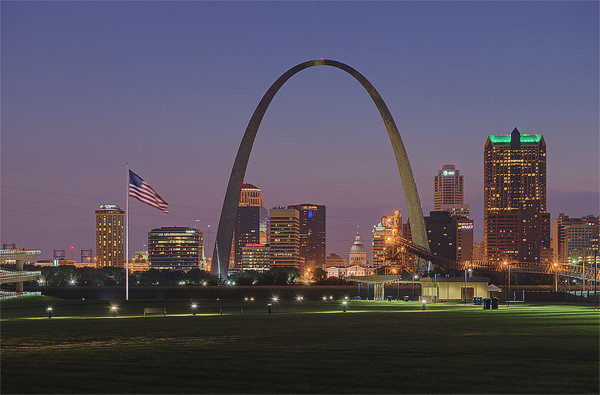
Designed in 1947 by the Finnish-American architect Eero Saarinen (1910-1961), the stainless steel-clad Gateway Arch was selected in 1948 by a jury of prominent architects to be the principal element of the Jefferson National Expansion Memorial, a monument in honor of Thomas Jefferson and the westward expansion of the United States. Construction was from 1963 to 1965, and it opened to the public in 1967.
Like many of the High Modernist architects, Eero Saarinen was classically trained, and we ought not be surprised that he, like many of his contemporaries, was able to produce elegant designs. When the architectural schools dropped the classical ideals, even Modern architecture suffered. I ought to note that Saarinen was until recently one of the most hated of Modern architects; perhaps because he was less of an independent artist with a personal vision, but instead took his clients' needs into great consideration. He lately has had a rehabilitation and his works are now getting more respect among architectural historians.

The Gateway Arch is one of the most-visted tourist attractions in the world, with over three million visitors every year.
 The unrelenting Modernism of the park design, however, means that there isn't too much for the tourist to see or do. The Arch is in a park that is grand in scale yet offers only severe vistas — vast expanses of lawn, two concrete-edged lakes, and pathways lined by trees of one species. A monumental staircase goes to the decayed and (now) mostly unused riverfront below. Like much of Modernism, detail is lacking on a human scale. Many features commonly found in parks, like historical markers, picnic tables, shade pavilions, kiosks selling food and cold beverages, and even public restrooms are missing from this rather plain landscape.
The unrelenting Modernism of the park design, however, means that there isn't too much for the tourist to see or do. The Arch is in a park that is grand in scale yet offers only severe vistas — vast expanses of lawn, two concrete-edged lakes, and pathways lined by trees of one species. A monumental staircase goes to the decayed and (now) mostly unused riverfront below. Like much of Modernism, detail is lacking on a human scale. Many features commonly found in parks, like historical markers, picnic tables, shade pavilions, kiosks selling food and cold beverages, and even public restrooms are missing from this rather plain landscape.Between the legs of the Arch, concrete steps descend into a visitors' center that includes shops, theaters, and a museum. All visitors must go thorough a security checkpoint. For a fee, you can ride to the top of the Arch, although I wouldn't recommend it if you are either claustrophobic or afraid of heights, but it is otherwise worth the trip up.
[The elevator to the top is a series of capsules, that resemble the interior of a clothes dryer. It is a very tight fit, having been designed back in the days when folks were far less fluffy than they tend to be now. When the capsules ascend, they rotate noticeably, and then abruptly readjust to become vertical again. I had assumed that these were controlled by some sort of mechanical ratchet, but rather there were mercury relays attached to the capsules, and when a certain angle was reached, the relay would fire and an electric motor would readjust the capsule. An old friend of mine re-designed the control system for these capsules, eliminating the relays as well as the abrupt ratcheting effect — it turns out folks missed this, and so he installed a master switch that could turn the ratcheting on or off.]
A map of the area immediately points out a major flaw of the monument:
View Larger Map
The Arch grounds are separated from the rest of downtown Saint Louis by Memorial Drive and Interstate 70. Visitors going between the Arch and Old Courthouse must cross two busy streets and go over the highway on narrow sidewalks.
These two major flaws were addressed in a new design competition, and a revised plan for the Arch was announced this week. See the article Tweaked Arch plan gets price tag: $578 million. The new plan revitalizes the old proposal to cover over Interstate 70 and to remove Memorial Drive, as well as changing the landscaping on the Arch grounds, that will include a new, grand, ground-level entrance to the Arch. A gondola car system is to transport visitors from the Arch to a new visitors' center located across the river: including Illinois in this plan may make funding more forthcoming. The parking garage located on the Arch grounds is to be removed, the riverfront itself is to be renovated, and the road there is to be elevated a bit to lessen its chances of being flooded by the Mississippi River.
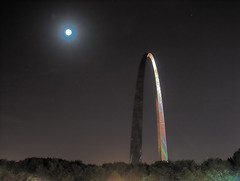 Consider the irony of destroying nearly the entirety of historical downtown Saint Louis in order to create a monument to history. Granted, the area where the Arch now sits was once a dangerous warehouse district, and had a bad reputation at least from the 1870s. The idea of a great memorial there was conceived in 1933 and was approved by U.S. President Franklin Roosevelt in 1935. Destruction commenced in 1939 and was completed in 1942, using power of eminent domain. A few remaining warehouse buildings of this era can be found just north of the Arch at Laclede's Landing. However, this monument was not to be a look back, but rather was forward-looking.
Consider the irony of destroying nearly the entirety of historical downtown Saint Louis in order to create a monument to history. Granted, the area where the Arch now sits was once a dangerous warehouse district, and had a bad reputation at least from the 1870s. The idea of a great memorial there was conceived in 1933 and was approved by U.S. President Franklin Roosevelt in 1935. Destruction commenced in 1939 and was completed in 1942, using power of eminent domain. A few remaining warehouse buildings of this era can be found just north of the Arch at Laclede's Landing. However, this monument was not to be a look back, but rather was forward-looking.When reviewing the historical documents of the monument's planning, I am struck as to how little any local input was allowed; the men involved in the planning and design were largely all national figures, and the financing of the monument came primarily from the Federal government. Local input came mainly from elected officials and large business owners, such as the Terminal Railroad Association: but even local business interests were largely ignored, since they were clamoring that at least a small part of the land be dedicated to parking, a demand the went unheeded until late in the design process.
The monument competition's jurors unanimously selected Saarinen's proposal and were strong proponents of Modernism; this selection was praised by the New York Times, while local opinions were often extremely negative. Local opinion is now more positive: whatever its flaws, it is ours, and the love of things just because they are familiar is no vice.
 Controversy grew when Saarinen's proposal was discovered to be similar to a design approved by the Italian Fascist dictator Benito Mussolini for a Universal Exposition in Rome. This controversy was dismissed because the concept was abstract enough to have been easily discovered independently, and Saarinen himself considered the controversy to be joke. However, that is a primary danger with abstraction: take for example the simple plain Christian cross, symbolizing any of a large number of varying communities, contradictory creeds, and any form of belief or disbelief; while a Cross with a bloody and battered corpus bearing the Five Wounds and Crown of Thorns can only be, and must be, Catholic, and can only symbolize the Sacrifice and Redemption wrought by Christ. However, it is because of this ambiguity that abstraction and iconoclasm is desired by revolutionaries. Certainly the Modernists wanted to erase the past and shape the future in a new direction.
Controversy grew when Saarinen's proposal was discovered to be similar to a design approved by the Italian Fascist dictator Benito Mussolini for a Universal Exposition in Rome. This controversy was dismissed because the concept was abstract enough to have been easily discovered independently, and Saarinen himself considered the controversy to be joke. However, that is a primary danger with abstraction: take for example the simple plain Christian cross, symbolizing any of a large number of varying communities, contradictory creeds, and any form of belief or disbelief; while a Cross with a bloody and battered corpus bearing the Five Wounds and Crown of Thorns can only be, and must be, Catholic, and can only symbolize the Sacrifice and Redemption wrought by Christ. However, it is because of this ambiguity that abstraction and iconoclasm is desired by revolutionaries. Certainly the Modernists wanted to erase the past and shape the future in a new direction.Very few historical buildings from the site were preserved. The Old Courthouse, from the very beginning, was intended to become the main historical centerpiece of the monument, and the Gateway Arch was placed specifically along the main axis of the Courthouse to provide a frame for it. The Old Courthouse contains a museum that both portrays the Manifest Destiny of the United States as well as the Dred Scott trial that eventually sparked the American Civil War. The museum under the Gateway Arch opened in the 1970s and is largely unchanged to this day; it primarily focuses on U.S. President Thomas Jefferson, the Lewis and Clark Expedition, the West, and includes environmentalist themes.
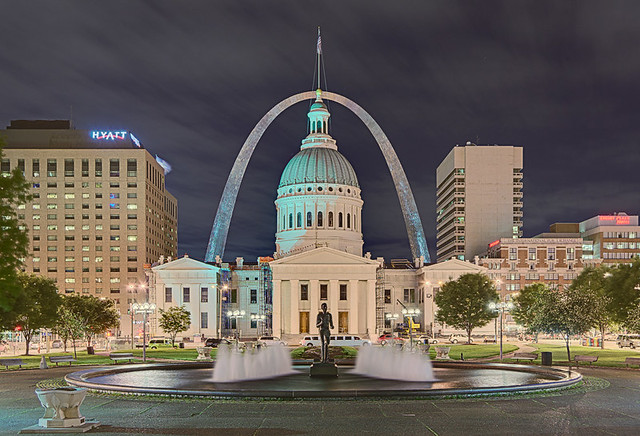
Although large numbers of warehouses were destroyed to make room for the Arch, the architectural ornament from these buildings were preserved and were to be exhibited in a museum that was planned to be located near the site; this never came to fruition, and I am unaware of what happened to this ornament. (Although have a look at the website of the St. Louis Building Arts Foundation).
One building that was preserved, for a while, was fur trader Manuel Lisa's Old Rock House from 1818. It was renovated and turned into a museum, but was destroyed when the Terminal Railroad was relocated into an underground tunnel.
Locals wanted to preserve other buildings, including the Old Customs House and an historic hotel; National Parks officials declined to save these. The Customs House would have been too expensive to restore, while the hotel was too heavily modified from its original condition. They too were destroyed.

While I have much sympathy with historical preservation, one problem is the attitude that disrespects the organic development of a building. Buildings naturally are modified and adapted over the years according to need. Catholics familiar with liturgical reform ought to be quite aware of this process, and the chaos caused by a supposed return to the historical purity of the liturgy — that was actually a revolution. Indeed, it seems that historical preservation and Modernism actually go hand-in-hand and are brothers-in-arms of the Revolution. Consider that many building codes place severe restrictions on historic buildings: in some localities, they must only be restored according to historic standards while using only traditional materials and construction methods, and if they cannot be preserved authentically, then they must inevitably be destroyed. New construction, again according to many building codes, must be of modern design and materials.
Old buildings, at best, are turned into museums. Orthodox architecture may use traditional designs while using the materials and building methods most appropriate for its time. Philosophically, form is more important than matter, and so the design of a building is more important than the materials or construction methods that make it. Contemporary philosophy often tends to confuse form and matter, and places a greater emphasis on matter than form. The Gateway Arch is considered great because it is made of stainless steel, while its form is so simple as to be almost meaningless. Reconstruction of the Old Rock House was abandoned because many of the original stones disintegrated — even though more stones of the same kind could have been easily quarried locally. In both of these cases, lowly matter was considered more important than the greater form of the building.
Urban renewal — the destruction of vast urban areas simply because they are old and usually poor — has destroyed buildings on a scale comparable to 20th century warfare. Although Urban Renewal was a trend most popular in the 1950s and 1960s, the Michigan city of Detroit may soon become the target of this kind of renewal, or rather destruction on a vast scale. This attitude can be found in U.S. Vice President Hubert Humphrey's speech at the inauguration ceremony of the Gateway Arch in 1968: the development of the Arch gave a "new sense of urgency to wipe out every slum". "Whatever is shoddy, whatever is ugly, whatever is waste, whatever is false, will be measured and condemned". Harsh words, but typical. This reminds me of Boethius: wicked men are actually powerless; they are incapable of doing good and can only destroy — and urban renewal in Saint Louis largely had terrible results. There are alternatives.
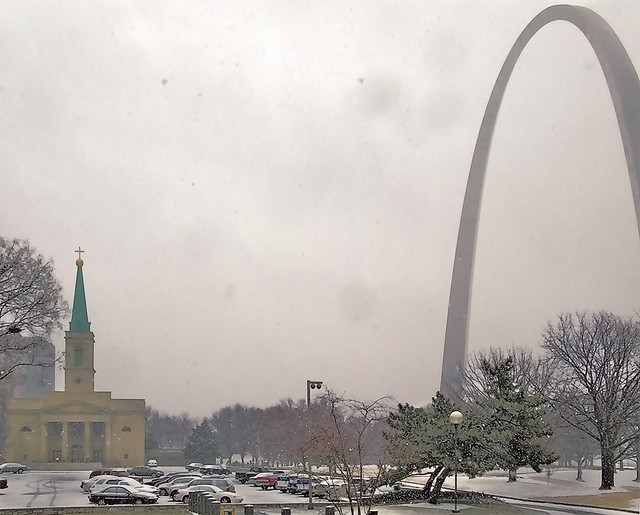
One other building that was preserved is the Basilica of Saint Louis, King of France, or the Old Cathedral, once the Cathedral church for half of the United States. At one time, this was one of the most highly indulgenced churches in the world, gaining all of the privileges of all the major basilicas of Rome. It has very many tourists and is popular for weddings.
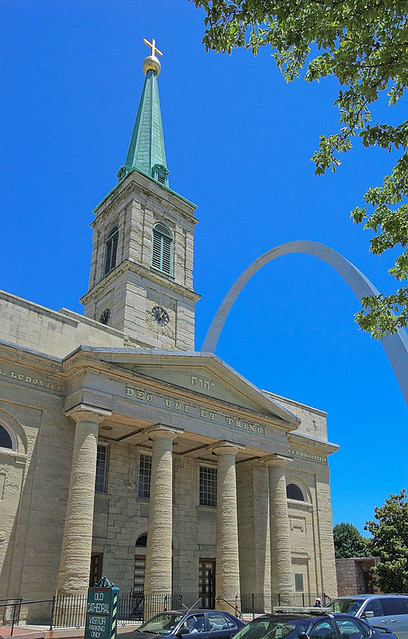
This church is a part of the Archdiocese of Saint Louis and offers daily Mass and Confession. According to the U.S. Department of the Interior, this was to be preserved because it retained most of its original design, although they did destroy the rectory and built a new one more in line with the design of the Arch grounds. It was nice of them to let us keep our church.
The Catholic and Royal history of Saint Louis is barely represented by the monument. It is interesting to compare the Catholic and American histories of this region: the Royal empires typically had modest aims and they knew that nothing was certain; they typically worked hard to have good relations with the native population, who after all, were fellow brethren in Christ. If a Frenchman owned a slave, he prostrated himself in church side-by-side with his slave as equals before God Incarnate, with the Master being far more liable to judgement and eternal damnation. On the contrary, Americans believed that the Grand Architect of the Universe preordained the conquest of the continent, and that Indians and slaves were sub-human, deserving nothing, not even life, if they were not useful. If you can believe it, contemporary American theories are even worse.
While I like seeing both old buildings restored to their original condition and bright shiny new buildings, I most prefer keeping things as they basically are, with good maintenance, occasional improvements, and new construction where it is needed. Nothing needs to be done on a large scale. ‘Improvements’ on a vast scale are often ill-conceived, and future generations often will attempt to reverse these, requiring great cost. Everybody wants progress, but we simply disagree on what progress means.


That's an incredible essay! I just started following ROTW again after losing you for about a year... and I don't regret coming back.
ReplyDeleteDid you ever find out about that picture of Ritter? Star of Rome of the West?
I'm sure a lot of your readers would appreciate it!
Excellent article, Mark, and thank you for your insights with regards to architecture and history. I am following you from Belgium and I enjoy a new surprise everytime I view this blog. Thanks for promoting the beautiful Catholic city of Saint Louis.
ReplyDeleteA terrific article, thanks.
ReplyDeleteI just came across your article while researching the "Arch." You might be interested in reading the updated Cultural Landscape Report on the National Park Service's website to give you a little more perspective on its development: http://www.nps.gov/jeff/parkmgmt/loader.cfm?csModule=security/getfile&PageID=249387
ReplyDeleteThe intent of the Jefferson National Expansion Memorial was not to preserve history but rather to commemorate historical events of national significance with a memorial. Because of this, the NPS removed all buildings that were not determined to have national significance. Hence, the Old Courthouse remained because of its association with the Dred Scott Trial and the Old Cathedral remained because it was considered the earliest home of western religion on the western bank of the Mississippi.
Also, it is important to understand that the "modern" landscape that exists today is far from what landscape architect Dan Kiley intended. Your essay criticizes the modernist design stating that "Many features commonly found in parks, like historical markers, picnic tables, shade pavilions, kiosks selling food and cold beverages, and even public restrooms are missing from this rather plain landscape." You might be interested to know that Saarinen and Kiley originally intended the grounds to be full of activity with pavilions, cafes, multiple museums, a sculpture park, a frontier village, and so forth. The memorial has a long and complicated history but basically ongoing budget restraints prevented many proposed features from ever being built while other features had to be simplified (such as the curvilinear ponds which, according to one site plan, proposed small islands linked with pedestrian bridges.